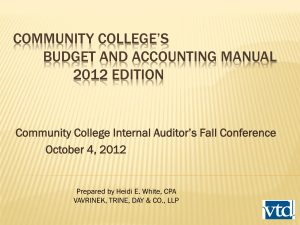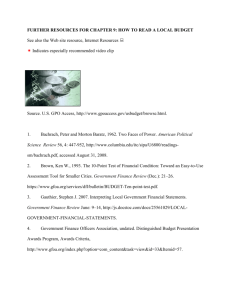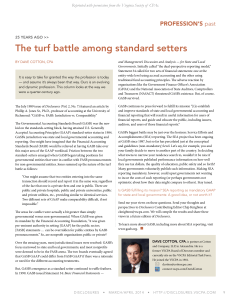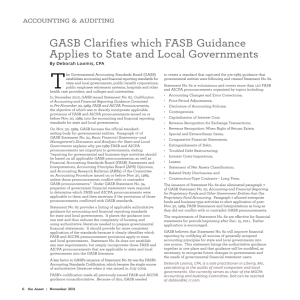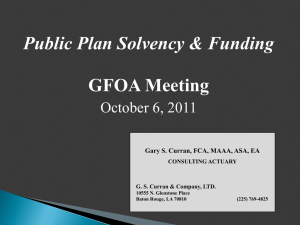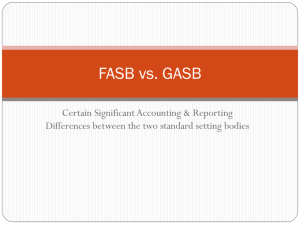Memorandum No - North Carolina State Treasurer
advertisement
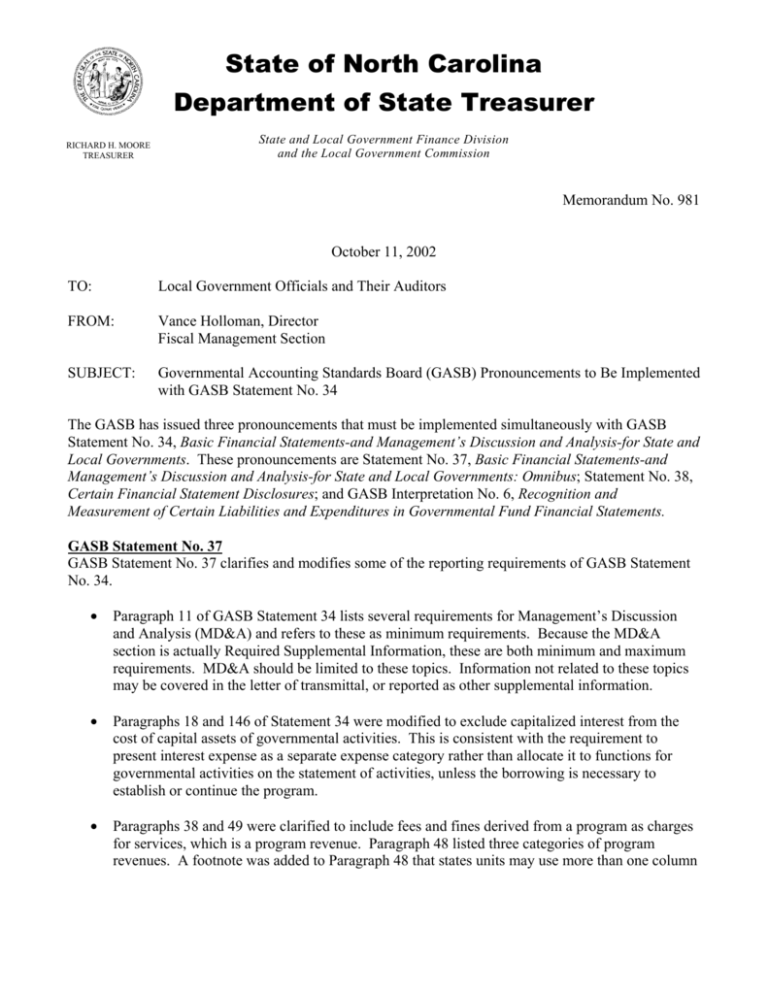
State of North Carolina Department of State Treasurer RICHARD H. MOORE TREASURER State and Local Government Finance Division and the Local Government Commission Memorandum No. 981 October 11, 2002 TO: Local Government Officials and Their Auditors FROM: Vance Holloman, Director Fiscal Management Section SUBJECT: Governmental Accounting Standards Board (GASB) Pronouncements to Be Implemented with GASB Statement No. 34 The GASB has issued three pronouncements that must be implemented simultaneously with GASB Statement No. 34, Basic Financial Statements-and Management’s Discussion and Analysis-for State and Local Governments. These pronouncements are Statement No. 37, Basic Financial Statements-and Management’s Discussion and Analysis-for State and Local Governments: Omnibus; Statement No. 38, Certain Financial Statement Disclosures; and GASB Interpretation No. 6, Recognition and Measurement of Certain Liabilities and Expenditures in Governmental Fund Financial Statements. GASB Statement No. 37 GASB Statement No. 37 clarifies and modifies some of the reporting requirements of GASB Statement No. 34. • Paragraph 11 of GASB Statement 34 lists several requirements for Management’s Discussion and Analysis (MD&A) and refers to these as minimum requirements. Because the MD&A section is actually Required Supplemental Information, these are both minimum and maximum requirements. MD&A should be limited to these topics. Information not related to these topics may be covered in the letter of transmittal, or reported as other supplemental information. • Paragraphs 18 and 146 of Statement 34 were modified to exclude capitalized interest from the cost of capital assets of governmental activities. This is consistent with the requirement to present interest expense as a separate expense category rather than allocate it to functions for governmental activities on the statement of activities, unless the borrowing is necessary to establish or continue the program. • Paragraphs 38 and 49 were clarified to include fees and fines derived from a program as charges for services, which is a program revenue. Paragraph 48 listed three categories of program revenues. A footnote was added to Paragraph 48 that states units may use more than one column Memorandum #981 Governmental Accounting Standards Board (GASB) Pronouncements to Be Implemented with GASB Statement No. 34 Page 2 to display any one of the categories of program revenues and may use more descriptive category headings than those in Paragraph 48. • Paragraph 48 also was clarified to state that for charges for services, the revenue should be reported as program revenue and assigned to the function that generates the revenue. For grants and contributions, the revenue is shown in the function or program to which it is restricted. In the illustrative financial statements prepared by this office, fines and forfeitures revenues are presented as program revenues (charges for services) for public safety. Fines and forfeitures due to the local school administrative units are reported in an agency fund in the illustrative statements and are therefore not reported in the government-wide financial statements. • Paragraph 39 addresses the level of detail to present for business-type activities in the statement of activities. That paragraph was modified to indicate the level of detail to present is different identifiable activities. Different identifiable activities would be different types of services for which specific revenues and expenses can be determined. For instance, electrical services and water services should not be combined. Different water districts in a county may be presented as a single identifiable activity since they provide the same type of service. If you have a water and sewer fund, these activities are reported together as one identified activity. If water and sewer are reported as separate funds, then they may be reported together or separately. The one exception to this is if the unit has issued revenue debt for which only water or only sewer revenues are pledged. In that case, each activity would be separately identifiable and would require separate reporting. • Paragraph 67 list three criteria for defining an enterprise fund. Paragraph 67c identifies a pricing policy that is intended to recover the cost of the fund, including capital cost, as criteria for identifying an enterprise fund. A footnote was added to clarify that this criteria applies to fees charged to external users not internal charges by an internal service fund. • Paragraph 76 was clarified to state that for a fund to be considered major, both the 5% and 10% criteria must be met for the same element of comparison (assets, liabilities, revenues or expenditure/expense). • Paragraph 88 lists several items that should be presented as other financing sources and uses in governmental fund statements. Paragraph 88 was clarified to list the face amount of debt rather than the proceeds of debt as an other financing source. Premiums (other financing sources) and discounts (other financing uses) on debt, which represent the difference between the proceeds of debt and the face amount, are also listed separately in Paragraph 88. The change was made because “proceeds” implies that the amounts should be netted. • Paragraph 122, which requires presentation of segment information in the notes to the financial statements, was clarified. Segment disclosures are only necessary if an identifiable activity has debt supported by pledges of revenue that contain covenants requiring that separate information be collected and reported. Assume that a county has more than one water district that is presented as a blended component unit. For any district that has debt supported by a pledge of revenues of that district, segment information would be required. Memorandum #981 Governmental Accounting Standards Board (GASB) Pronouncements to Be Implemented with GASB Statement No. 34 Page 3 • Paragraph 126, which established component unit reporting requirements, was clarified. If a unit presents major component unit information, that information would be based upon the total reporting entity for that component unit. If the component unit has its own component units, the total reporting entity should include all of its component units. • Paragraph 131 was clarified to indicate that over expenditures by the General Fund or a major, annually budgeted special revenue fund should be disclosed in either the notes to the basic financial statements or the notes to the RSI, depending upon whether the budgetary comparison for these funds are presented in the basic financial statements or RSI. Local governments in North Carolina should include these budgetary comparisons in the basic financial statements, so over expenditures would be disclosed in the notes to the basic financial statements. Units should disclose material over expenditures in other funds as violations of the General Statutes. Statement 37 also made some modifications to Statement 34 concerning escheat funds and use of the modified approach to report infrastructure that should not impact local governments in North Carolina. The Statement should be implemented at the same time as GASB Statement No. 34. GASB Statement No. 38 The GASB reconsidered the disclosure requirements imposed by many different reporting standards as a single body of standards. Disclosures have been modified, deleted and added. The Statement establishes a general policy regarding disclosures in that disclosures can be made either on the face of the financial statements or in the notes to the financial statements, but not in both places. It also changes the target audience of the notes to the level of a reasonably knowledgeable user. The following is a discussion of the changes to the note disclosures as a result of GASB 38: • If a unit uses more than a single column when presenting the primary government in the basic financial statements, the summary of significant accounting policies should include a description of the unit’s major governmental and enterprise funds, internal service funds and fiduciary funds. With the exception of the General Fund, those descriptions should be specific to the unit rather than general definitions. The unit should also disclose in the summary of significant accounting policies the period of time used to define availability for recognition of revenues on the modified accrual basis of accounting. • If significant violations of finance-related legal or contractual provisions are disclosed, units should also disclose any actions taken to address the violations, and any consequences that may result from the violation. • Debt service requirements should present principal and interest payments to maturity. This information should be presented separately for each of the next five fiscal years, and thereafter in five-year increments to maturity. For variable rate debt these disclosures should be based upon the rates in effect at the balance sheet date. Terms by which the variable debt may change also should be disclosed. Units also should disclose the minimum payments under capital leases and Memorandum #981 Governmental Accounting Standards Board (GASB) Pronouncements to Be Implemented with GASB Statement No. 34 Page 4 noncancelable operating leases for each of the next five fiscal years, and in five-year blocks thereafter. • Any short-term debt activity during the year, such as bond anticipation notes, should be disclosed. This requirement applies even if all short-term debt has been issued and repaid during the year. Short-term borrowings through lines of credit or loan are not permitted by the General Statutes and should also be disclosed as a violation of the General Statutes. • Receivables and payables to and from different parties, such as employees, taxpayers, other governments and vendors, are sometimes combined on the face of the financial statements. Governments should consider their activities and circumstances and ascertain the components, if any, that best describe their receivables and payables and disclose that information either in the notes or on the face of the fund financial statements. If receivables are not expected to be collected within one year, that should be disclosed on the face of the financial statements or in the notes as well. • Details about interfund balances and transfers should be disclosed in the notes. Amounts due between major individual funds, nonmajor governmental funds, nonmajor enterprise funds, internal service funds and the fiduciary fund-types should be disclosed. The purpose of the balances and any balances not expected to be repaid within a year of the balance sheet date also should be disclosed. Amounts and the purposes of transfers between major individual funds, nonmajor governmental funds, nonmajor enterprise funds, internal service funds and the fiduciary fund-types should also be disclosed. The supplemental schedule of interfund transfers is eliminated. • The disclosure requirements for the accounting policy for encumbrances and the general budget policies are removed. The illustrative notes to the financial statements issued by this office will include limited disclosures about the legal requirements for adopting and amending the budget for readers. The effective date of GASB Statement No. 38 is the implementation date of GASB Statement No. 34, with the exception of disclosures about short-term debt, receivables and payables and interfund balances and transfers. For Phase 1 units only, these disclosure requirements can be implemented one year after implementation of GASB Statement No. 34. For all other phases, the implementation dates of these disclosures are the date of the implementation of GASB Statement No. 34. The illustrative financial statements prepared in accordance with GASB Statement No. 34 have been updated to reflect all disclosure requirement changes. GASB Interpretation No. 6 Governmental fund financial statements are prepared using the modified accrual basis of accounting. Expenditures are recognized in the period in which the fund liability is incurred. Fund liabilities are liabilities expected to be paid from current financial resources. This Interpretation addresses some questions that have arisen in what constitutes a fund liability for preparation of governmental fund financial statements under GASB Statement No. 34 as follows: Memorandum #981 Governmental Accounting Standards Board (GASB) Pronouncements to Be Implemented with GASB Statement No. 34 Page 5 • Liabilities and expenditures that are usually paid from available resources as they come due would be recognized as an expenditure and fund liability when incurred. Examples would include salaries, utilities and other operating expenses. The liability would be recognized in the fund even if the fund did not have enough currently available resources to pay the liability at the time incurred. Only the GASB may determine what types of liabilities may be accounted for as general long-term liabilities. • General long-term indebtedness would be a general long-term liability rather than a governmental fund liability. This would not apply to indebtedness of proprietary or fiduciary funds. The liability would appear in the governmental activities column of the government-wide statements, but not on the balance sheet of the governmental fund statements. This would apply to debt issues such as bonds and installment purchases, but would also apply to other general long-term indebtedness such as compensated absences, claims and judgments and closure and postclosure care cost of landfills not accounted for in an enterprise fund. • Liabilities and expenditures for other long-term liabilities such as compensated absences, claims and judgments and closure and postclosure care cost of landfills not accounted for in an enterprise fund are recognized when the liabilities are expected to be paid with available financial resources. This occurs when the liabilities come due. Therefore, fund liabilities and expenditures for these long-term liabilities would be recorded in the fund when they come due. For compensated absences, this would generally occur only when an employee was terminating service and an actual payment was required. This also will generally require that an arbitrage rebate liability only be shown as a governmental fund liability when it is due and payable at the end of the five-year calculation period. The accumulation of resources in a governmental fund to pay these amounts as they come due does not cause a fund liability and expenditure to be recorded. If a government would like to accumulate resources for the payment of these employee benefit related claims and recognize a fund liability, the use of an internal service fund for these employee benefits will be necessary. • If funds have been placed in a debt service fund to pay general long-term debt issues that come due early in the next fiscal year, that liability may be recorded in the debt service fund. Early in the next fiscal year means within the first month of the fiscal year. If the General Fund or any fund other than a debt service fund is holding the funds for repayment, that fund would not record a fund liability. The funds must be in a debt service fund and designated to pay the debt issue that comes due in the first month of the next fiscal year. The government must also be externally required, typically by a bond order, to set aside the monies in a debt service fund. Interpretation No. 6 should not result in any changes in the way local governments had been recognizing governmental fund liabilities and expenditures prior to implementing GASB Statement No. 34. The Interpretation should be implemented in the same fiscal year as GASB Statement No. 34. Memorandum #981 Governmental Accounting Standards Board (GASB) Pronouncements to Be Implemented with GASB Statement No. 34 Page 6 The illustrative financial statements prepared in accordance with GASB Statement No. 34 by this office have been updated for these GASB pronouncements. If you have any questions please contact Sharon Edmundson at 919-807-2394 or Sara Shippee at 919-807-2386.
